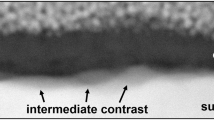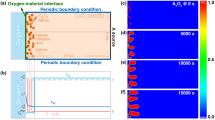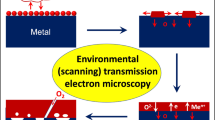Abstract
A theoretical approach is presented to calculate the critical volume fraction f * v for the transition from internal to external oxidation. The focus was on the evolution of internal-oxide volume fraction during the initial stage of oxidation. An equation to calculate f * v was developed by considering an effective diffusion coefficient of oxygen in the alloy (D eff O ) which takes into account the evolving blocking effect by forming internal oxide precipitates. Based on this physical process, three types of oxidation behavior can result, depending on the properties of the alloy and exposure atmosphere. Further discussions on the remaining discrepancy between predicted and experimentally-determined f * v values are provided for refinement on the theoretical prediction of this parameter.










Similar content being viewed by others
Notes
Wagner and other treatment have used other notations for this critical volume fraction but they are physically the same.
References
L. S. Darken, Transactions of the AIME 54, 600 (1961).
C. Wagner, Zeitschrift-fuer-Elektrochemie 63, 772 (1959).
Since Wagner’s paper was written in Germany, this paragraph was found in a book by David Young, in “High Temperature Oxidation and Corrosion of Metals”, Elsevier Science; 1 edition (October 17, 2008).
R. A. Rapp, Acta Materialia 9, 730 (1961).
A. Nesbitt, Journal of the Electrochemical Society 136, 1511 (1989).
J. B. Leblond, Oxidation of Metals 75, 93 (2011).
J. S. Kirkaldy, in Oxidation of Metals and Alloys, ed. D. L. Douglass (American Society of Metals, Metals Park, 1971), pp. 101.
I. V. Belova and G. E. Murch, Defect and Diffusion Forum 79, 218 (2003).
J. C. Maxwell, Treatise on Electricity and Magnetism, (Clarendon Press, Oxford, 1904).
G. H. Neale and W. K. Bader, AIChE Journal 19, 112 (1973).
Z. Hashkin and S. Shtrikman, Journal of Applied Physics 33, 3125 (1962).
S. Prager, Physica 29, 129 (1963).
R. E. De la Rue and C. W. Tobias, Journal of the Electrochemical Society 106, 827 (1959).
H. Fricke and S. Morse, Physical Review 25, 361 (1925).
M. R. J. Wyllie and M. A. R. Gregory, Transaction of the AIME 198, 103 (1953).
R. K. Schofield and C. Dakshinamurti, Faraday Society Disc 3, 56 (1948).
C. S. Giggins and F. S. Pettit, Journal of the Electrochemical Society 118, 1782 (1971).
J. Park and C. J. Altstetter, Metallurgical and Materials Transactions A 18, 43 (1987).
W. Gust, H. B. Hintz, A. Lodding, H. Odelius and B. Predel, Physica Status Solidi 64, 187 (1981).
M. M. P. Janssen, Metall. Trans. 4, 1623 (1973).
Scheil and Kiwit, Archiv Eisenhuttenwesen 9, 405 (1936).
G. Böhm and M. Kahlweit, Acta Materialia 12, 641 (1964).
Paper was written in Germany. The referenced part was translated in the paper of: R. A. Rapp, Corrosion 21, 382 (1965).
F. Gesmundo, P. Castello, F. Viani and C. Roos, Oxidation of Metals 49, 237 (1998).
Acknowledgments
This work was funded by the Cross-Cutting Technologies Program at the National Energy Technology Laboratory, managed by Susan Maley (Technology Manager) and Charles Miller (Technical Monitor). The Research was executed through NETL Office of Research and Development’s Innovative Process Technologies (IPT) Field Work Proposal. This work was financially supported at the University of Pittsburgh by NETL through the RES Contract No. DE-FE00400.
Disclaimer
This report was prepared as an account of work sponsored by an agency of the United States Government. Neither the United States Government nor any agency thereof, nor any of their employees, makes any warranty, express or implied, or assumes any legal liability or responsibility for the accuracy, completeness, or usefulness of any information, apparatus, product, or process disclosed, or represents that its use would not infringe privately owned rights. Reference herein to any specific commercial product, process, or service by trade name, trademark, manufacturer, or otherwise does not necessarily constitute or imply its endorsement, recommendation, or favoring by the United States Government or any agency thereof. The views and opinions of authors expressed herein do not necessarily state or reflect those of the United States Government or any agency thereof.
Author information
Authors and Affiliations
Corresponding author
Appendices
Appendix 1
Determining volume fraction (f v ′) from mole fraction (N BOv ′)
where V oxide m , V alloy m are molar volumes of BOν and alloy and \(Z \equiv \frac{{\pi N_{O}^{S} D_{O} }}{{vD_{B} \left( {N_{B}^{0} } \right)^{2} }}\)
Appendix 2
Mathematical derivation to determine f * v (after Leblond [6]).
Letting f ′v = f v, the Eq. (12) becomes:
This can be converted to a quadratic equation:
where R = V oxide m /V alloy m .
For the critical transition point, the quadratic equation has a unique solution, which means the discriminant is zero:
From that, we can determine Z as a function of R:
When the quadratic Eq. (15) has a double solution, this solution is
Substituting Z 1 into the Eq. (16), it is found that f v is negative, which is not realistic for a volume fraction.
Therefore, the only solute is obtained by substituting Z 2 into Eq. (16), which is:
Rights and permissions
About this article
Cite this article
Zhao, W., Kang, Y., Orozco, J.M.A. et al. Quantitative Approach for Determining the Critical Volume Fraction for the Transition from Internal to External Oxidation. Oxid Met 83, 187–201 (2015). https://doi.org/10.1007/s11085-014-9516-1
Received:
Revised:
Published:
Issue Date:
DOI: https://doi.org/10.1007/s11085-014-9516-1




